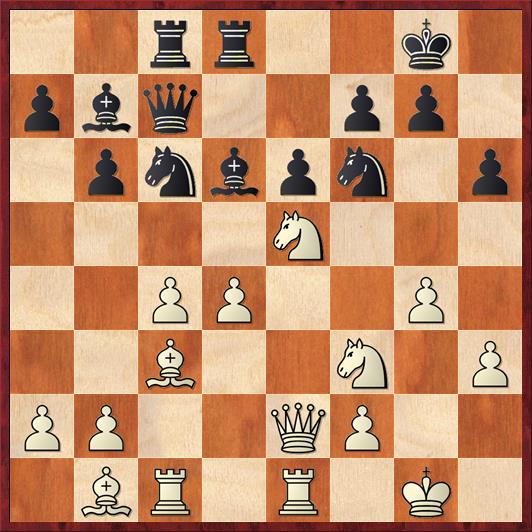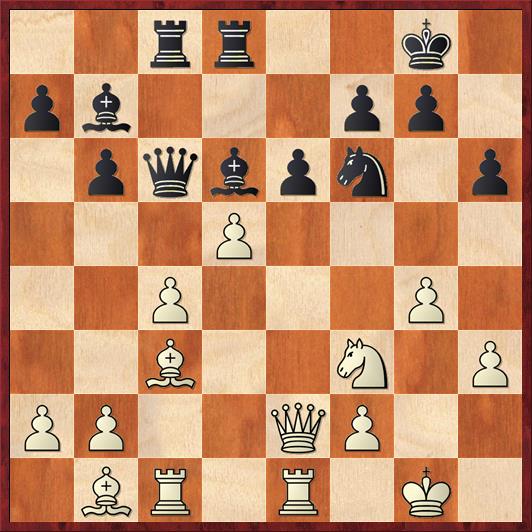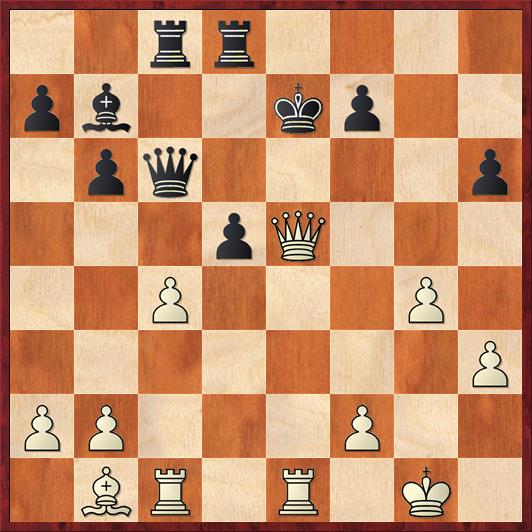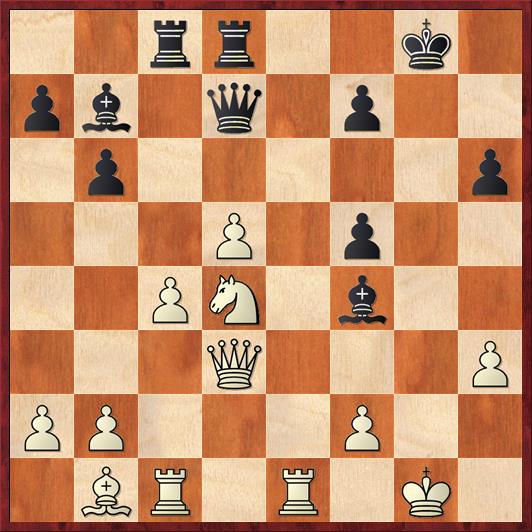For the last six months I haven’t been posting as much as usual to my blog, because I’ve been working on a (non-chess) book. I’m glad to say that I sent the first draft of the book to my editor today. Though there is still a lot to do, I feel as if I can now re-emerge from the shell that I’ve been in for the last half year. I can get back to enjoying life, playing chess, and writing in this blog!
To get things started, I’d like to show an interesting position that I played against the computer last week. I’m White against Shredder, which I had set at a rating of 2302. I don’t beat it very often at that level, so I was pretty pleased with this game!
 Position after 20. … Rfd8. White to move.
Position after 20. … Rfd8. White to move.
FEN: 2rr2k1/pbq2pp1/1pnbpn1p/4N3/2PP2P1/2B2N1P/PP2QP2/1BR1R1K1 w – – 0 21
White is definitely comfortable here, with an extra pawn and a space advantage. On the other hand, there are also some weaknesses on the kingside. I usually allow myself one time-out per game when playing Shredder, and I decided that this was a good time for it. Before the time-out, my top four candidate moves were 21. g5, 21. h4, 21. b3, and 21. Nxf7. Which of these moves would you play — or would you play something else entirely?
The more I looked at the position, the more I realized that it would be a big risk to open up the position with a move like 21. g5 or 21. h4. Black’s bishops eye the kingside in a very threatening way, and there is also a neat trick Black can play in several lines: 21. … Nxe5 22. de (apparently winning a piece due to the fork, but…) Bc5! 23. fe?? Qg3+! with mate to follow. For example, if 21. Nd2 (a move I considered even though it wasn’t on my original list of candidate moves) Nxe5 22. de Bc5! 23. b4 Rxd2!! and White has to give back all of his material to avoid getting mated. Likewise, 21. g5 hg 22. Nxg5 Nxe5 22. de Bc5 23. b4 Qc6 is completely fine for Black.
So then I started thinking about Mike Splane’s approach to such positions. If you have an advantage, he says, take your time! Because White is a pawn up, he should just keep control over the position, try to shut down Black’s counterplay, and the game should just take care of itself. From this point of view, 21. b3 is a nice simple move that protects a weakness in White’s position and asks Black what he is going to do.
In fact, 21. b3 is Rybka’s third-favorite move, with a +0.77 advantage for White. So it’s definitely not bad. But I didn’t really see a plan for White, other than sitting around and waiting for Black to make a mistake. Against a human that might work, but against a computer it probably won’t.
In fact, one of my arguments with Mike is that you also need to keep an eye out for unique opportunities — tactical moves that you may not get another opportunity to play. This is exactly the opposite of the “wait-and-do-nothing” approach. Does White have any tactical opportunities here? Well, that’s the thinking behind 21. Nxf7. Unfortunately, that move is way too optimistic. It gives away White’s material advantage for no good reason after 21. … Qxf7 22. Qxe6 Qxe6 23. Rxe6.
But there is one other possibility for White that wasn’t on my original list of candidate moves. Hint: What piece is not currently participating in White’s attack, and how would you like to get it involved?
The answer: The bishop on c3! At present it is playing a completely defensive role, but what if we could move the knight on e5 and the pawn at d4 out of the way? Then the bishop could remove Black’s only kingside defender and shatter the pawn formation with Bxf6.
So the move I played was 21. Nxc6!
At first this move seems crazy. That’s why it didn’t occur to me at first. I just said that White has to watch out for Black’s bishops, so why would I help Black out by opening the long diagonal for him?
The answer is that I am going to close that diagonal right away! After 21. … Qxc6 I played the followup pawn sacrifice, 22. d5!
This kind of pawn move is called a sweeper sealer, and it is a beautiful example of the genre.
 Position after 22. d5. Black to move.
Position after 22. d5. Black to move.
FEN: 2rr2k1/pb3pp1/1pqbpn1p/3P4/2P3P1/2B2N1P/PP2QP2/1BR1R1K1 b – – 0 22
Given the fact that I was not planning to play this move, it is amazing how perfectly my pieces are set up to make it work.
Here are some of the possibilities:
(A) 22. … Nxd5 23. cd Qxd5 24. Be4! totally shuts down Black’s attack. (Interestingly, this move would not work with the pawn on b3, because of the weakness of White’s bishop on c3. I invite the reader to work out the details. For that reason 21. b3? would have been a mistake — it not only overlooks White’s main tactical resource but also ruins White’s chance of playing it later.)
(B) 22. … Qxc4 23. Qxc4 Rxc4 24. Bxf6 Rxc1 25. Bxd8! Sheer serendipity. Black’s rook just happened to be hanging on d8, and White’s rook just happens to be defended on e1. White ends up with an extra piece (although it does take a little work to keep the bishop on d8 from getting trapped).
(C) 22. … ed is of course the main variation. Now we see the point of the “sweeper sealer.” The pawn has simultaneously swept open the a1-h8 diagonal for White’s bishop and sealed the a8-h1 diagonal for Black’s bishop and queen. In most examples of this theme, the “seal” is more permanent than it is in this position. Here it is a very temporary seal; Black will move his d-pawn out of the way next move. But it doesn’t matter; the gain of one tempo means that White can checkmate Black with Qh7+-Qh8 faster than Black can checkmate White with … dc, … Qxf3 and … Qg2 mate. The proof of the pudding is the line 22. … ed 23. Bxf6! gf (or 23. … Re8 24. Qd3 g6 25. Qd2! Bf8 26. Bc3!) 24. Qd3 Be5 (there is nothing better) 25. Qh7+ Kf8 26. Nxe5 fe 27. Qh8+ Ke7 28. Qxe5+ (diagram)
 Position after 28. Qxe5+ (analysis). Black to play.
Position after 28. Qxe5+ (analysis). Black to play.
FEN: 2rr4/pb2kp2/1pq4p/3pQ3/2P3P1/7P/PP3P2/1BR1R1K1 b – – 0 28
In this cute position, Black’s only move to stop checkmate is 28. … Qe6, but he loses a queen for a rook after 29. Qg7 (or any other queen “sidestep”).
Shredder didn’t like any of those lines, and instead it chose 22. … Qd7 in the second diagram above. But then White easily gets a winning advantage with 23. Bxf6! gf 24. Qd3 f5 25. gf ef 26. Nd4 Bf4 (diagram).
 Position after 26. … Bf4. White to move.
Position after 26. … Bf4. White to move.
FEN: 2rr2k1/pb1q1p2/1p5p/3P1p2/2PN1b2/3Q3P/PP3P2/1BR1R1K1 w – – 0 27
Here White has lots of ways to win, but I like the one I chose: 27. Nxf5! With this move White says that he is not concerned about losing the rook on c1 because after 27. … Bxc1 28. Nxh6+! forces mate. Instead Shredder played 27. … Bxd5 and I opted to go into a winning endgame with 28. Ne7+ Kf8 29. Nxd5 Bxc1 30. Rxc1. I eventually did win, by trading queens, trading rooks, and then pushing my queenside pawn majority.
To me, the two main lessons from this example are:
- Do not be too quick to dismiss a move that looks “anti-positional” (like 21. Nxc6, which seems wrong because it opens up the a8-h1 diagonal for Black). Tactics do override positional considerations sometimes.
- Keep an eye out for sweeper-sealers! This type of pawn break often looks impossible, as the pawn can often be taken in multiple ways. But the key is that when your opponent takes the pawn, he blocks his own lines. Meanwhile, the pawn advance opens lines for you. Without these two ingredients, the sweeper-sealer wouldn’t work (or it wouldn’t be a true sweeper-sealer).



{ 1 comment… read it below or add one }
Thank you very much for the work you offer in this blog. It’s really useful for us club players. Congrats!